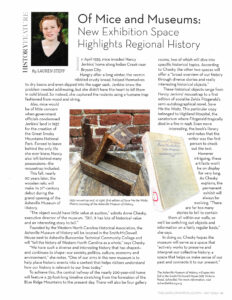History Feature: Of Mice and Museums
New Exhibition Space Highlights Regional History
Read in The Laurel – July 2023
By Lauren Stepp
In April 1935, mice invaded Nancy Jenkins’ home along Indian Creek near Bryson City.
Hungry after a long winter, the vermin nibbled crusty bread, helped themselves to dry beans and even dipped into the sugar sack. Jenkins knew the problem needed addressing, but she didn’t have the heart to kill them in cold blood. So instead, she captured the rodents using a humane trap fashioned from wood and string.

Mousetrap, 1935. Photo courtesy of the Asheville Museum of History
Alas, mice would be of little concern when government officials condemned Jenkins’ land in 1937 for the creation of the Great Smoky Mountains National Park. Forced to leave behind the only life she ever knew, Nancy also left behind many possessions—the mousetrap included.
This fall, nearly 90 years later, the wooden relic will make its 21st-century debut during the grand opening of the Asheville Museum of History.
“The object would have little value at auction,” admits Anne Chesky, executive director of the museum. “Still, it has lots of historical value and an interesting story to tell.”
Founded by the Western North Carolina Historical Association, the Asheville Museum of History will be located in the Smith-McDowell House next to Asheville-Buncombe Technical Community College and will “tell the history of Western North Carolina as a whole,” says Chesky.
“We have such a diverse and interesting history that has shaped—and continues to shape—our society, politics, culture, economy and environment,” she notes. “One of our aims in the new museum is to help place historic events into a context that helps visitors understand how our history is relevant to our lives today.”

First edition of Save Me the Waltz. Photo courtesy of Asheville Museum of History
To achieve this, the central hallway of the nearly 200-year-old home will feature a 35-foot-long timeline stretching from the formation of the Blue Ridge Mountains to the present day. There will also be four gallery rooms, two of which will dive into specific historical topics. According to Chesky, the other two spaces will offer a “broad overview of our history through diverse stories and really interesting historical objects.”
These historical objects range from Nancy Jenkins’ mousetrap to a first edition of socialite Zelda Fitzgerald’s semi-autobiographical novel, Save Me the Waltz. This particular copy belonged to Highland Hospital, the sanatorium where Fitzgerald tragically died in a fire in 1948. Even more interesting, the book’s library card notes that the writer was the first person to check out the text.
However intriguing, these artifacts won’t be on display for very long. As Chesky explains, the permanent exhibit will always be evolving.
“There are far too many stories to tell to contain them all within our walls, so we’ll be switching out objects and information on a fairly regular basis,” she says.
In doing so, Chesky hopes the museum will serve as a space that “actively works to preserve and interpret our collective history: a space that helps us make sense of our past and connects it to our present.”
The Asheville Museum of History will open this fall in the Smith-McDowell House (283 Victoria Road, Asheville). For more information, visit AshevilleHistory.org.

